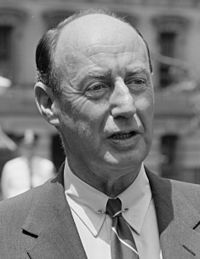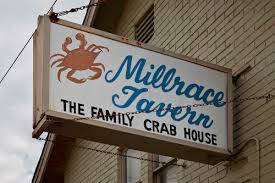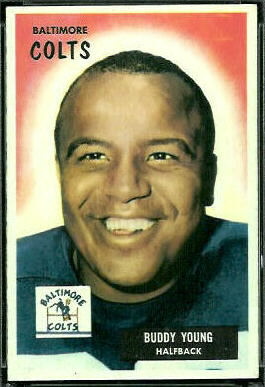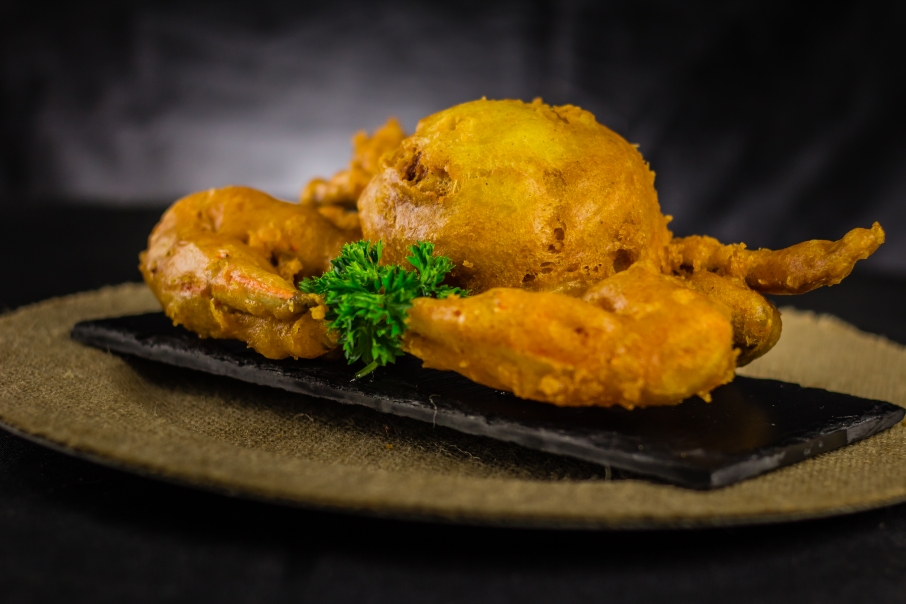
Former Illinois Gov. Adlai E. Stevenson was the Democratic Party’s nominee for President, running unsuccessfully for the second time against popular incumbent Dwight D. Eisenhower, in 1956. Steven- son campaigned on the west side of Balti- more but didn’t get any tough questions from the city’s wealthiest black residents.
ROOBY TAWR, a novel in progress
set in mid-20th Century Charm City
By Joel Foreman
Janie Shear had Adlai Stevenson and Montgomery Alabama on her mind as she hurried her homeward bound Pontiac Star Chief along the sinuous curveway winding through Leakin Park.
Earlier that day her husband Booney had unexpectedly met the Democratic nominee for President outside of a tire store in West Baltimore. Now she wanted to find out if Booney actually told Stevenson what he said he’d say — “right to the man’s face” — if he ever had the chance.
The big car skidded, swayed and sent two items to the floor, a paper bag crimped at the top and bearing the words “Millrace Tavern,” and a book, Invisible Man, Janie had been reading while waiting for her takeout order.
The bag contained a favorite Maryland dinner, deep-fried hard-shell crabs! Called “Buddy Young Specials,” they were first served at the Millrace at a party the Baltimore Colts running back hosted in 1953 to celebrate the team’s 13-7 beatdown that year of the Chicago Bears.
Gino Marchetti, Art Donovan, Don Shula and Bert Rechichar were all there, as well as team owner Carroll Rosenbloom and investors like Zanvyl Krieger and Booney Shear.
Asked by Hall of Fame play-by-play announcer Chuck Thompson to describe the special recipe, Young said: “It’s simple! Pop the top (referring to the apron on the underside of the crab), clean out the gills and guts, stuff the cavity with cooked jumbo lump, do an Old Bay batter dip, and lower it gently into the deep fry.”
Booney Shear loved those deep-fried crabs. More, he’d say, than the Lobster Cardinale at Marconi’s, the Caesar salad at the Chesapeake, more than Jimmy Wu’s sweet and sour ribs, Haussner’s fried eggplant, even more than an Attman’s hot corned beef sandwich with chopped chicken liver.
When feasting on deep fries with his children, Booney would counsel them to “Take your time. Don’t rush it. This is a delicacy. Like foie gras. Only better!” And he’d demonstrate how you start, by nibbling off the crispy exterior.
“Once you finish with the crisp,” he’d say, “you have to decide: Go for the claws? Or go for that fat wad of luscious crabmeat waiting for you in the center?
“Either way, you win big!”
When Janie got home that night, she and Booney spread some pages from an old Afro-American newspaper on the kitchen table so they could get to work on the messy deep-fries.

Millrace Tavern, on Baltimore’s west side, was known for deep-fried hard-shell crabs, “the Buddy Young Special.”
Since eating something as good as a Buddy Young Special takes precedence over talking, Janie had to contain her curiosity about the unexpected encounter with Adlai Stevenson outside one of her husband’s properties — the garage housing the Ruby Tire Company on Fremont Avenue.
She wanted details but Booney was too busy nibbling the crisp off his crab’s exterior.
When he finished, he exclaimed, “Praise the Lord for His bounty!” contemplated the big claws he had detached from the body of the crab, looked at Janie, and said, “What’s it gonna be? Claw meat or jumbo lump?”
“I know a man who says you win either way,” Janie replied with a knowing smile. “Just pick one already and tell me if you told The Man what you said you were gonna say.”
Ignoring this query, Booney looked suggestively at Janie and replied, “Food is the second . . .” But Janie interrupted him, completing with a mocking tone what he was about to say.
“Food is the second-best thing the Lord made for us mortals. I’ve heard that line before, from the same man who said you win either way with claw meat or jumbo lump.
“So just go ahead and enjoy that crab, hon, because second-best is all you’ll get tonight if you don’t satisfy my curiosity — like now! — about what you did or did not say to Governor Stevenson.
“Now, c’mon,” she pleaded in her cute sassy way. “Tell me!”
Booney picked up his knife and small wooden mallet with feigned haste and said: “I better get moving then!”
He placed the sharp edge of the knife against one of the big claws and gave it a smart tap with the mallet, just enough to make a crack in the shell without damaging its meat. Then he broke the shell all the way through so it could be lifted away to reveal an intact hunk of marine perfection.
He held it up like a trophy and waited for Janie to acknowledge his skillful extraction.
“Some fine achievement,” she said with a voice Booney recognized as Janie’s mocking high-tone imitation of Leticia LeCompte, her mother:
“You, my Janie, sent to the best schools and exposed to all the arts and humanities. You could have had Harvard and Wall Street but you settled for a Howard graduate, a landlord’s son, a man so common he takes pride in, of all things, being a good crab picker.”
“I did OK,” Booney retorted. “Met the next President of the United States of America, didn’t I?”
So Booney finally tells Janie how earlier he was getting some new rubber on his car “at Rooby Tawr” when he heard a ruckus on the street, went curbside to see what it was all about, and watched the slow progress up Fremont Avenue of two motorcycle cops in advance of a big Oldsmobile 98 convertible.
“I thought I had seen that car before,” Booney said. “It was Walter’s. Walter Dixon. Same one he used when he was campaigning for City Council.”
Janie knew Dixon, knew the car, had socialized with his wife, worked with the Colored Women’s Democratic Club to register 4th District voters on his behalf, and felt quite proud to help elect the first African-American to serve on the Baltimore City Council since 1930.
“That’s good,” she thinks. “Walter with a presidential candidate. That’s a sign of some progress.”
“Walter and Stevenson are waving to people,” Booney continued, “and driving so slow that Walter sees me and, next thing, the car’s pulling over to the curb where I’m standing with some other people.
“Stevenson’s got his shirt sleeves rolled up. It’s a hot afternoon and he’s got a handkerchief to mop that egghead of his. They both stand up and Walter tells Adlai that I’m ‘Mr. Booney Shear, a prominent figure in the Baltimore Negro community.’
“And the next President reaches out to give me one of those two-handed politician handshakes. Looks right in my eyes. Says how pleased he is to meet me.”

Buddy Young was a halfback for the Baltimore Colts before the team’s storied “glory days” of the 1950s.
When Booney’s done, Janie, seemingly unimpressed, wants to know, “Did the ‘prominent figure in the Baltimore Negro community’ tell The Man what he said he was gonna tell him?”
“Tell him what?” asks Booney, a little irritated and defensive.
He knows what’s coming.
“What you said the other night when you were riled up about the bus boycott, and Virginia closing its schools, and the ‘congressional crackers’ — Strom Thurmond and his bunch of racists — claiming they had a constitutional right to massively resist desegregation.
“Here, I’ll remind you,” Janie says, and proceeds, with chest puffed out and hands on her hips, to give a pretty good imitation of her husband spouting off:
“What’s that man Stevenson talking about, ‘gradual change’? We’ve had enough ‘gradual.’ I’d tell him to his face if I could. Gradual’s not good enough anymore.
“Hell no! And I want to know what you, the Democratic nominee for President, are going to do about it.”
“Is that what I said?” Booney asks sheepishly, as if he doesn’t remember; then admits: “Well, I guess it was easier to say that to you than to him. You know, I mean… I, uh… didn’t want to embarrass Walter.”
With that, Janie glances up sweetly at her husband, the smile returning to her lovely face, and whispers: “Tea Cake” — a pet name she uses for Booney — “you’re my man.
“I dearly love you and I always will.”
But then she sighs and takes a deep breath, bows her head, and makes a mental note in silence to herself:
“There’s a lotta hard mountain still to climb!”
joelforeman@voiceofbaltimore.org
CHECK OUT EXCERPTS 1-4 OF ROOBY TAWR (ROGERS ROOBY — Waiting for a streetcar in 1930s Baltimore; PAGET’S DISEASE — Deuteronomy’s grave vision of a vortex, while trimming tawr teats; ‘ANY BONDS TODAY?’ — Bugs Bunny and the Good Jew; and ARMISTICE DAY — Baltimore’s German heritage and the Great War) by clicking here, here, here, AND here.
EDITOR’S NOTE:
The working title of Joel Foreman’s book, Rooby Tawr, refers to the main character Reuben Michael and the Baltimorese pronunciation of the word “tire.”
All characters depicted in this work are fictitious. Any resemblance to real persons, living or dead, is purely coincidental. However photos depicting fictitious characters and places are grounded in reality.
Joel Foreman was born in Baltimore, attended Baltimore City College and graduated from Milford Mill High School in 1960. A member of the English Department at George Mason University for more than 35 years, he is now Professor Emeritus, having published some 30 articles on Hollywood cinema, the Internet and education, video games and computer generated graphics, along with other works.
The novel in progress Rooby Tawr is Foreman’s initial foray into fiction. (For his complete thumbnail biography, click “Staff” under the Main Menu at left.)







December 15th, 2015 - 10:38 PM
[…] 'BUDDY YOUNG SPECIALS' — Adlai Stevenson and hard-shell crabs (Excerpt 5) Former Illinois Gov. Adlai E. Stevenson was the Democratic Party's nominee for President, running unsuccessfully for the second time against popular incumbent Dwight D. Eisenhower, in 1956. Steven- son campaigned on the west side of Balti- more but … Read more on Voice of Baltimore […]
December 17th, 2015 - 1:16 PM
I’m so proud of you cousin. Wonderful to read about days of yore. Just think, if Stevenson had been married he would have been president! Such narrow mindedness!
Uncle Ruby’s kids sure are talented. Wish some Foreman talent had rubbed off on me!
Hugs,
Carolyn
December 20th, 2015 - 7:28 PM
Joel Foreman:
I enjoyed reading this artfully-told, insightful and funny short story. I think it has many revealing hints about the complexities of black-white relations in 1950s urban America.
December 21st, 2015 - 11:37 AM
Joel
I really enjoy reading these vignettes. I am ashamed to say that I moved to Arlington in 1951, and after college and grad school moved back in 1971, yet can count the number I have visited Baltimore on only two hands. So immersing myself in its culture via your narrative is quite eye opening and exhilarating. ak
December 22nd, 2015 - 7:44 PM
Good on ya, Bro! Words of memory & wonder. Mazel tov & L’chaim!
November 25th, 2016 - 8:41 PM
[…] and hard-shell crabs) by clicking here, here, here, here, and here. EDITOR’S […]